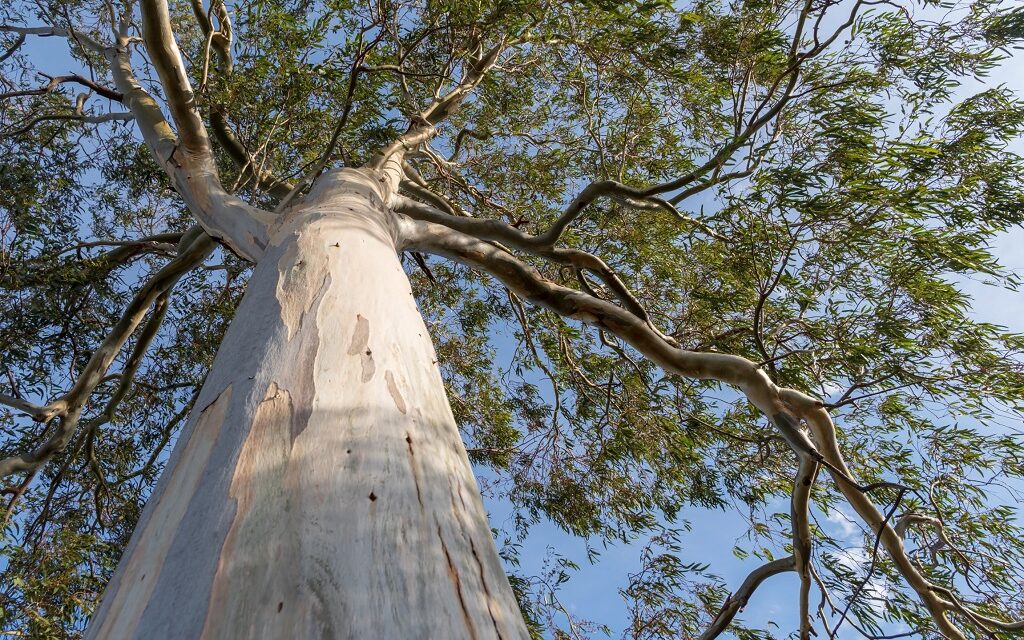Updated: May 8, 2022
When evaluating the appeal and health of a home’s landscaping, be sure to assess the trees surrounding the property, especially when purchasing a new home. The beauty and shade offered by surrounding trees can have deceptive benefits, as certain trees can have detrimental impact on your home, as well as your neighbors’ properties.
Choosing the right species of tree can be the difference between enjoying cool, low-maintenance shade during the summertime heat, and incurring massive bills resulting from tree-related damage.
Table of Contents
- Traits of Dangerous Trees
- Assessing Trees on Your Property
- Our Example of Why You Should Know the Average Lifespan of Nearby Trees
- The Cost of Tree Removal
- The Risks of Dangerous Trees
- Shopping for Safe Trees
Also see:
Traits of Dangerous Trees
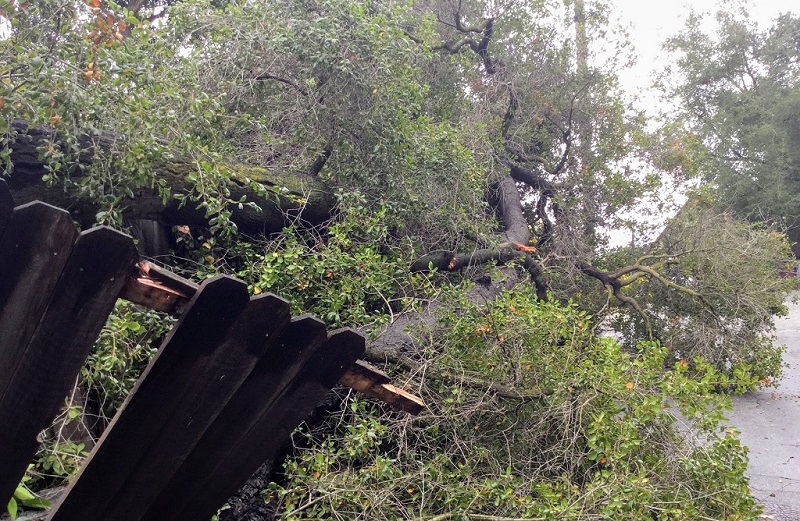
No one really considers the damage that a 40-foot tree can cause when they look at the majestic structure of a pine or oak on their property or when considering a new home. As homeowners, we tend to see the immediate benefit of shade, privacy and beauty, when assessing the area surrounding a home.
Though there are many ways, reasons and situations why trees can cause damage to your home, here are the underlying traits of dangerous trees of which you should be aware:
- Invasive Root Systems: trees with aggressive lateral root systems that have infiltrated a home’s foundation or sewer lines
- Older Trees That Have Reached Their Peak Maturity: trees that have short-remaining lifespans and are susceptible to falling or breaking down
- Younger Trees with Unknown Futures: still growing trees that were placed too close to the home or may block valuable views when mature
- Invasive Trees: non-native tree varieties that may disturb the balance of your property’s eco-system, by aggressive over growth, disease, mold, or unwanted pests
- Highly Flammable Trees: certain tree varieties, like large, mature oil-laden Eucalyptus trees that are prone to explode when catching on fire
Most homeowners rarely give thought to the underlying root systems of nearby trees and the potential for that tree to topple onto the roof or surrounding structures at some point in the future.
Having lived through many “wind events” and El Nino winters in Southern California, we can attest to the fact that older trees can have dangerous implications for homeowners and prospective buyers. Recurring assessments of your landscape and trees are always a smart preventative measure and is worth the investment, if a professional arborist is needed.
Invasive Root Systems
Maturing trees with expanding invasive root systems are another unforeseen hazard that homeowners seldom consider, as they place too much emphasis on a tree’s canopy of leaves, without giving consideration for what’s growing underground.
Older Trees That Have Reached Their Peak Maturity
Knowing a tree’s average life span is also important for knowing the timing of a tree’s mortality and proactively preventing sudden danger to your home and property.
Younger Trees with Unknown Futures
Knowing the life span and future growth potential of your trees are also critical to prevent future issues, such as invasive root systems growing into the home’s foundation, or valuable views being obstructed (including your neighbors’ views).
Assessing Trees on Your Property
Taking note of the trees and shrubs around a property is important before purchasing a home. Many trees that we have grown to love, such as apple trees, peach trees and other fruit varieties, have an average lifespan of 15-35 years. If you are purchasing an older home, consider how long that a tree has already lived and factor maintenance or removal into the cost of owning the home.
If trees are an important part of your purchase decision making, consider properties with coniferous trees, such as Blue Spruce, White Pine or Douglas Firs, which can live to be 350, 200 and 1,200 years-old, respectively.
The Worst Trees to Plant Near Your House
Also be cautious of trees that are a hindrance to the home’s foundation and infrastructure, such as Oak, Poplar and Ash trees, as their robust lateral root systems will require that you continually trim and maintain their roots away from the foundation.
Though home inspections are a well-known part of the home buying process, tree inspections are often forgotten. Whether in process of buying a home, or needing to assess your current property, always hire a certified arborist to evaluate the trees on your property.
Also see:
- Why Hire an Arborist?
- Home Inspection Technologies to Alleviate Your Purchase Anxiety
- If You Own a Fireplace, You’ll Want to Read This
- Non-Invasive Plumbing Tech for Repairing Your Home’s Sewer Line
Our Example of Why You Should Know the Average Lifespan of Nearby Trees
We recently lost a 20+ year-old Bradford Pear (Pyrus Calleryana) during a sudden Santa Ana windstorm. We later learned that the average lifespan of a Bradford Pear tree was very short, ranging between just 15 and 25 years.
One day our tree was beautifully majestic, sheltering our great room terrace from the California sun. The next day it instantly split from a sudden, violent Santa Ana gust of wind, making a cracking sound we will never forget.
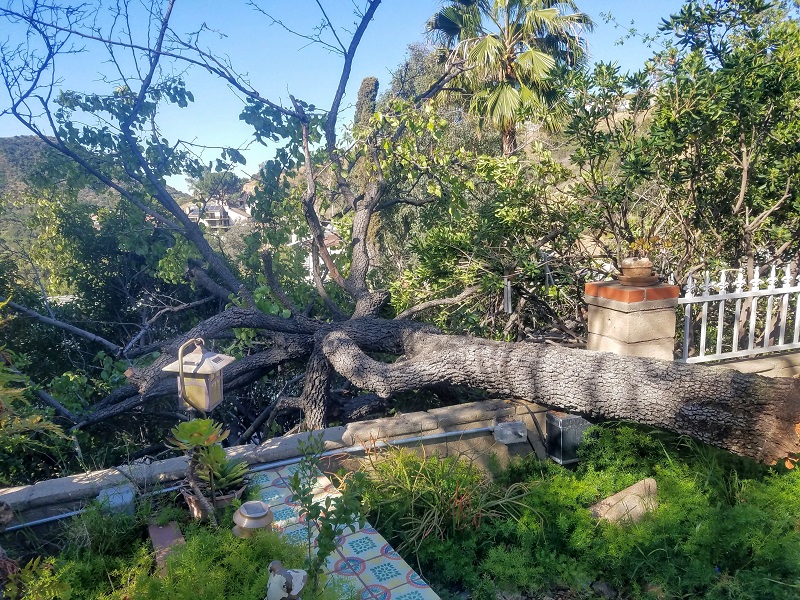
Fortunately, we were relieved to discover that the tree had fallen away from our house, partially resting on a low brick wall and a surrounding hillside. Yes, we were sad to lose our beloved Bradford, but oh, were we relieved that our home was spared.
The Cost of Tree Removal
Tree removal can be an extremely costly and highly variable endeavor. We reached out to over five tree removal services to get a bid on cutting and hauling the tree, and were amazed at the range of prices. Although, we gave the same information to all of the contractors, some chose to come and take a look before bidding, while others asked for a photo in order to assess the damage.
The range in price was significant – from $400 to $1,500 – for cutting limbs and branches, hauling of debris, and sweeping up of the area. Not one proposal included stump removal. Given the nature of the accident (inclement weather conditions), we recognized that we were in competition with other nearby residents, who were also seeking tree removal services.
Keep in mind that size of the tree was relatively modest – e.g. approximately 20 feet tall with a canopy about the same width as its height.
We learned that the factors that determine tree removal pricing are size of the tree, location and unforeseen potential dangers, such as should the tree continue to cause more damage as it is being cleared and if workers can be harmed in the process. Only hire licensed contractors who are fully bonded and insured and those who can provide proof of workman’s compensation to the employees they bring on your property.
The Risks of Dangerous Trees
Having already mentioned the traits that can make residential trees dangerous to your property, here are several common situations that demonstrate these risks:
Foundation
Foundation damage is an unforeseen circumstance that, when discovered, is already at a point where other signs have pointed an investigation toward underlying lateral roots systems. Rarely do tree roots themselves cause foundation issues, the problem is when roots find their way into existing foundation cracks and proceed to enlarge the spaces between the cracks. Foundation issues will have several telltale signs such as:
- Uneven doors or window frames
- Vertical crack in interior walls
- Cracked windows or shattered glass
- Floor cracks or uneven floors
All is not lost if you catch these issues in time, as there are a number of ways to prevent further damage before the problem causes the red tagging of the structure:
- When planting trees around your property, always install root barriers. The barriers deflect roots away from the home’s foundation and cause the roots to seek deeper ground away from plumbing, and hardscaping.
- Roots can be maintained after the facts by trimming and maintenance, but we suggest that this should be performed by a professional arborist as any damage to a trees root system may have a negative impact on the health and life of the tree.
- Consider cutting down the tree and removing the root system entirely to prevent further damage to the homes foundation and infrastructure. Although this sounds like a surgical response, this may be the only defense you may have to saving the home’s foundation.
If, however, you do not resolve your foundation issue in time, unfortunately, the worst-case scenario will be to raze your home and remove the invading trees. The first time we became aware of the seriousness of aggressive root systems was while watching a home improvement show that chronicled this exact scenario. The root system was discovered during a home remodeling project, and as the situation was further investigated, there was no other feasible alternative remedy.
Plumbing
We recently had sewer line work completed on our 40-year-old home and were fortunate to discover that only one line had root damage. Since we live in a canyon surrounded by lots of nature, we expected the worst, as we performed routine maintenance on sewer lines throughout the property as a cautionary measure.
Our plumber gave us some sage advice on root systems and informed us that roots generally grow laterally when they encounter hard surfaces, such as pipes, sidewalks, and foundations.
However, if there is a moisture source such as a crack in a sewer line, foundation or other source of water, the roots will seek out these areas and invade the hard surfaces in search of nutrients.
Performing routine maintenance on plumbing (e.g. video inspections and cleanings) is a good preventative measure to ensure that root systems do not lead to more expensive repairs.
Trees with non-invasive root systems that can be placed in close proximity to the home’s structure, without fear of damage to plumbing or foundations, include the following tree varieties:
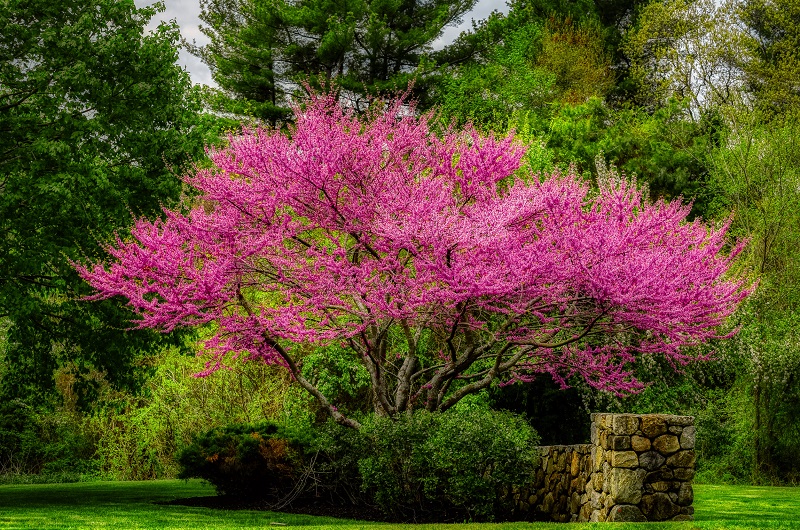
Redbud Tree in Spring
Fire Danger
Although all plants and trees are at risk of fire danger if not pruned or maintained regularly, there are some trees and shrubs that are classified as being highly flammable. Trees of this kind should not be planted next to structures and should be kept at least 30 feet away from your house. An example of an exceptionally flammable variety is the Eucalyptus tree (Eucalyptus Obliqua).
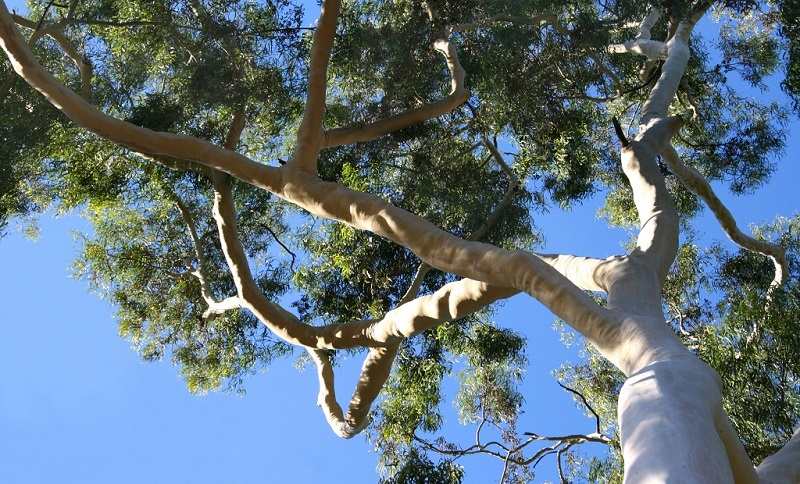
Eucalyptus trees are the most feared flora in Southern California and warmer climates, as their bark and leaves are filled with an aromatic oil which causes them to become highly combustible during fire season. Not surprisingly, although beautiful, aromatic and majestic, Eucalyptus trees were introduced to the United States in the 1850’s as ornamental plants for timber and fuel. When the tree sheds its bark, the piles of dead leaves and bark create the perfect tinder for the flammable oil that the tree emits, thus fueling an aggressive conflagration.
Knowing which trees and shrubs in and around your property are prone to ignition is an important first step toward prevention measures. These tree varieties are classified as being highly flammable:
- Eucalyptus
- Italian Cypress
- Ornamental Juniper
- Leyland Cypress
- Rosemary
- Bamboo
- Douglas Fir
Also see:
- Fire-Resistant vs. Highly Flammable Plants
- Eucalyptus: California Icon, Fire Hazard and Invasive Species
Wind
Shallow-rooted trees are at risk in high-wind areas. For example, on December 1, 2011, a massive wind event, known as “The Storm of the Century”, took place in the San Gabriel Valley of Southern California, which saw winds up to 160 miles per hour. These Category 4, hurricane-force winds downed trees, caused power outages to hundreds of thousands of residents and delayed flights in the surrounding areas.
In the city of Pasadena alone, the windstorm took down thousands of trees and caused damage to approximately 5,500 trees or 9% of the city’s arboriculture. The top six species of trees that suffered the most damage were: Live Oak; Chinese Elm; Southern Magnolia; Camphor; Queensland Pittosporum; and Holly Oak.
A report prepared by Pasadena’s Urban Forestry Advisory Committee – titled “Pasadena Windstorm Tree Failure Analysis” – had many eye opening conclusions based on the local forestry and the wide range of damage observed, with some lessons learned for homeowners.
If you live in an area susceptible to seasonal high winds such as Santa Anas, hurricanes or tornadoes, avoid shallow rooted trees, as they are prone to blow over or become uprooted.
Choose more wind resistant species such as:
- Sabal Palms
- Canary Island Date Palm
- Bald Cypress
- Buttonwood (AKA American Sycamore)
Shallow-rooted trees to avoid in high-wind areas, include these tree varieties:
- Spruce
- Sugar Maple
- Birch
- Maple
- Cotton Wood
Shallow-rooted trees especially present high risks in flood zones that encounter high winds, due to their large population. Unfortunately, if you live in an area prone to flooding, you may be tempted to grow shallow-rooted trees, as these areas can rob roots of nutrients and oxygen. Thus the roots fight for the surface to remain dry and healthy. However, the ability for shallow-rooted trees to thrive in damp areas, makes them more susceptible to high winds.
Nutrient Leeching
Invasive Trees that Leech Nutrients from the Soil
Many non-native species of trees were brought to the United States and allowed to proliferate and thrive before the US Department of Agriculture put safeguards in place to monitor and eradicate invasive species that are harmful to native trees and plants. These invasive trees and plants pose dangers to local ecosystems, namely local insects and wildlife, and other native trees and plants.
By crowding out competing native plants for nutrients, these invaders cause native trees to die off from disease or infestation and replace their native counterparts, while serving as inhospitable hosts to insects, birds and other wildlife.
Local conservation groups are helpful in identifying non-native or invasive species of trees and, together with homeowners can help eradicate undesirable infestations in local ecosystems.
Some of the most common invasive trees are:
- Black Locust
- Bradford Pear
- Black Alder
- Earleaf Acacia
- Mimosa or Silk Tree
- Norway Maple
- Siberian Elm
- Sycamore Maple
Before cutting down an invasive tree, speak with a local arborist to verify the species and to get advice on the best method of eradicating the crown, trunk and branches in the safest possible manner. Next, choose your tree’s replacement with a native species or non-invasive alternative.
Shopping for Safe Trees
When shopping for trees to plant around your home, be sure to shop on sites that provide some of the following selection filters that will help you not only find a safe tree, but one that will be well-suited for your specific location, such as:
- Hardiness Growing Zone
- Soil Type
- Sun Exposure
- Drought Tolerance
- Max Height at Maturity
- Max Width at Maturity
Here are a few helpful links to start your shopping journey on PlantingTree.com:
- Find Your Hardiness Growing Zone
- Front Yard Trees That Add Curb Appeal
- Trees For Privacy That Are Low Maintenance
- Fast Growing Privacy Trees
- Deer Resistant Privacy Trees
- Collection of All Tree Types
- PlantingTree.com Warranty Program
- PlantingTree.com Shipping Process
Recommended Reading
- Uber Apps for Lawn Care & Outdoor Services
- The Current State of Landscaping Technology for Your Home
- 7 Ingenious Tech Products for Weed and Pest Control
- Home Inspection Technologies to Alleviate Your Purchase Anxiety
- Non-Invasive Plumbing Tech for Repairing Your Home’s Sewer Line
| Purgula is reader-supported. When you click on links to other sites from our website, we may earn affiliate commissions, at no cost to you. If you find our content to be helpful, this is an easy way for you to support our mission. Thanks! Learn more. |

